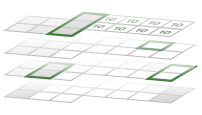While Project automatically provides you with default calendar settings (Monday through Friday, 8AM to 5PM), those defaults might not be the right fit for your projects. Here are a few topics that may answer some specific questions you have about making changes to your schedule:
Calendar related topics
Tip: If you don't need a calendar anymore, delete it!
How do all of these calendars work together?
There are four types of calendars in Project: base calendars, project calendars, task calendars, and resource calendars.
These calendars all stack together to frame how work is scheduled on a project.
An example...
Let's say your organization is located in Seattle, and has a typical work week of 8-hour work days, Monday through Friday. The base calendar reflects these working days and hours, as well as company holidays, like July 4 for Independence Day, and December 25 for Christmas.
A project manager starts a new project that runs from July 1 to July 15, and requires a Tuesday-Saturday work week.
The base calendar shows the Monday through Friday work week, with July 4 identified as a non-working holiday.
The project calendar uses the base calendar as a starting point, but adds that Saturdays are now working days, and Mondays are now non-working days.
One task in the project takes place in another country, so the July 4 holiday won't apply. The task calendar adds that July 4 is a working day.
Finally, the resource that will be working on the task has a different working schedule than the rest of your organization. The resource calendar adds that Tuesday is a non-working day, and Wednesday through Saturday are 10-hour days.
When Project schedules the task, it accounts for the assigned resource's calendar, the task calendar, the project calendar, and the base calendar.
The resulting availability contributes to how Project calculates the start and finish dates for the task and the project.


















